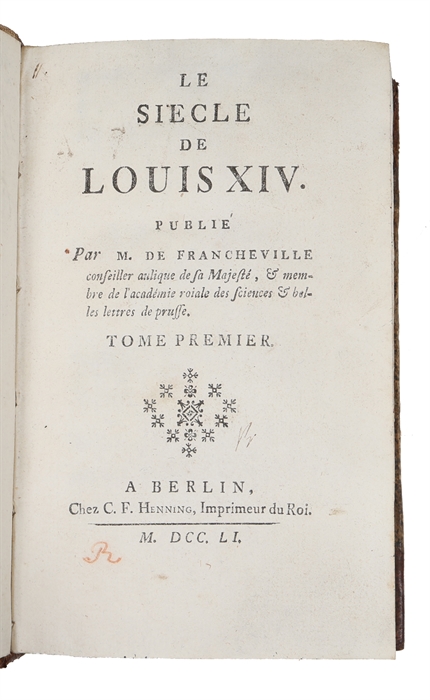ONE OF VOLTAIRE'S GREATEST HISTORICAL WORKS
VOLTAIRE, FRANCOIS-MARIE AROUET de.
Le Siècle De Louis XIV. 2 parts.
Berlin, C. F. Henning, 1751.
8vo. Two parts bound in one contemporary half calf binding with four raised bands and blind stamped ornamentation to spine. Small paper-label pasted on to top of spine. Wear to extremities, boards with scratches and lower part of front hinge with loss of leather. Front free end-paper with four line annotation in contemporary hand. Internally nice and clean. (12), 488, (4), 466, (4) pp.
First edition of one of Voltaire’s greatest historical works, arguably one of the most important political and cultural histories of this era - a monument of eighteenth-century historiography, paving the way not only for modern historiography but also literary history in general. “The Age of Louis XIV was the most thoroughly and conscientiously prepared of Voltaire’s works. He had planned it in 1732, begun it in 1734 put it aside in 1738, resumed it in 1750. For it he read two hundred volumes and reams of unpublished memoires, consulted scores of survivors from le grand Siecle, studied the original papers of protagonists like Louvois and Colbert, secured from the Due de Noailles the manuscripts left by Louis XIV, and found important documents, hitherto unused, in the archives of Louvre.” (Durant, The Age of Voltaire: The Story of Civilization, Volume IX). The period covered in this work spans from the later years of Cardinal Richelieu to the aftermath of Louis XIV's death. Voltaire characterized this era as a pinnacle of artistic and philosophical achievement, contrasting it with what he viewed as a decline during the reign of Louis XV. Voltaire's approach to history diverged from traditional accounts focused on great leaders and events. He aimed to capture the essence of the era like a painter, emphasizing broader historical and cultural movements over specific individuals or battles. He valued developments such as artistic progress, the decline of medieval superstitions and the end of sorcery and witch trials as significant markers of advancement.
In accordance with other Enlightenment authors and philosophers, Voltaire saw the age of Alexander the Great and Pericles, the age of Caesar and Augustus and the Italian Renaissance as "great ages". In the present work he presented the age of Louis XIV as the fourth and greatest.
Order-nr.: 61385


